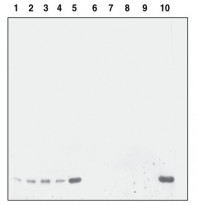ARG56500
anti-Phospholipase A2 V antibody
anti-Phospholipase A2 V antibody for Western blot and Human,Mouse,Rat
Overview
| Product Description | Rabbit Polyclonal antibody recognizes Phospholipase A2 V |
|---|---|
| Tested Reactivity | Hu, Ms, Rat |
| Tested Application | WB |
| Specificity | This antibody does not react to cPLA2, iPLA2 and Human synovial sPLA2 (Type II). |
| Host | Rabbit |
| Clonality | Polyclonal |
| Isotype | IgG |
| Target Name | Phospholipase A2 V |
| Antigen Species | Mouse |
| Immunogen | Synthetic peptide around an internal region of Mouse Phospholipase A2 V. |
| Conjugation | Un-conjugated |
| Alternate Names | Group V phospholipase A2; hVPLA(2); FRFB; GV-PLA2; PLA2-10; EC 3.1.1.4; Calcium-dependent phospholipase A2; Phosphatidylcholine 2-acylhydrolase 5 |
Application Instructions
| Application Suggestion |
|
||||
|---|---|---|---|---|---|
| Application Note | * The dilutions indicate recommended starting dilutions and the optimal dilutions or concentrations should be determined by the scientist. |
Properties
| Form | Liquid |
|---|---|
| Purification | Affinity purification with immunogen. |
| Buffer | TBS (pH 7.4), 0.02% Sodium azide, 50% Glycerol and 0.1% BSA. |
| Preservative | 0.02% Sodium azide |
| Stabilizer | 50% Glycerol and 0.1% BSA |
| Storage Instruction | For continuous use, store undiluted antibody at 2-8°C for up to a week. For long-term storage, aliquot and store at -20°C. Storage in frost free freezers is not recommended. Avoid repeated freeze/thaw cycles. Suggest spin the vial prior to opening. The antibody solution should be gently mixed before use. |
| Note | For laboratory research only, not for drug, diagnostic or other use. |
Bioinformation
| Database Links | |
|---|---|
| Gene Symbol | Pla2g5 |
| Gene Full Name | phospholipase A2, group V |
| Background | This gene is a member of the secretory phospholipase A2 family. It is located in a tightly-linked cluster of secretory phospholipase A2 genes on chromosome 1. The encoded enzyme catalyzes the hydrolysis of membrane phospholipids to generate lysophospholipids and free fatty acids including arachidonic acid. It preferentially hydrolyzes linoleoyl-containing phosphatidylcholine substrates. Secretion of this enzyme is thought to induce inflammatory responses in neighboring cells. Alternatively spliced transcript variants have been found, but their full-length nature has not been determined. [provided by RefSeq, Jul 2008] |
| Function | PA2 catalyzes the calcium-dependent hydrolysis of the 2-acyl groups in 3-sn-phosphoglycerides. This isozyme hydrolyzes more efficiently L-alpha-1-palmitoyl-2-oleoyl phosphatidylcholine than L-alpha-1-palmitoyl-2-arachidonyl phosphatidylcholine, L-alpha-1-palmitoyl-2-arachidonyl phosphatidylethanolamine, or L-alpha-1-stearoyl-2-arachidonyl phosphatidylinositol. May be involved in the production of lung surfactant, the remodeling or regulation of cardiac muscle. [UniProt] |
| Calculated MW | 16 kDa |
| PTM | This enzyme lacks one of the seven disulfide bonds found in similar PA2 proteins. |
Images (1) Click the Picture to Zoom In
-
ARG56500 anti-Phospholipase A2 V antibody WB image
Western blot: 1) 0.025 µg of Recombinant Human sPLA2 (Type V), 2) 0.05 µg of Recombinant Human sPLA2 (Type V), 3) 0.075 µg of Recombinant Human sPLA2 (Type V), 4) 0.1 µg of Recombinant Human sPLA2 (Type V), 5) 0.25 µg of Recombinant Human sPLA2 (Type V), 6) 50 µg of A10 smooth muscle cell lysate (iPLA2), 7) 1 µg of Bee venom PLA2, 8) 1 µg of Human sPLA2 (Type II), 9) 50 µg of HeLa cell lysate (cPLA2), and 10) 0.25 µg of Recombinant Human sPLA2 (Type V) stained with ARG56500 anti-Phospholipase A2 V antibody.






